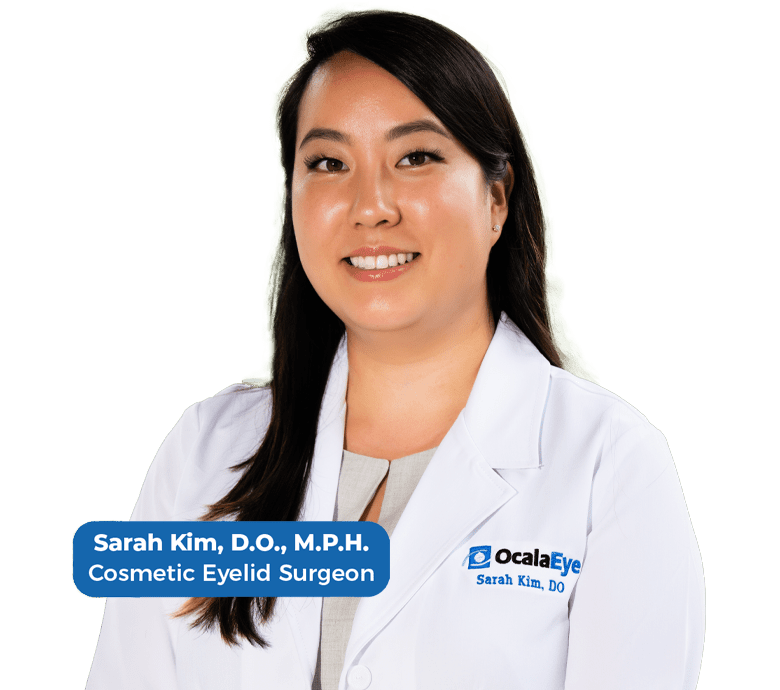Cosmetic Eyelid Surgery
 What is cosmetic eyelid surgery?
What is cosmetic eyelid surgery?- What are the benefits of cosmetic eyelid surgery?
- What are the types of cosmetic eyelid surgery?
- Are there risks associated with cosmetic eyelid surgery?
- What’s it like to recover from cosmetic eyelid surgery?
Over time, the delicate tissues around the eyes can make you appear tired and older than you are or feel. Your eyelid skin can start to stretch and sag, fat from behind your eyes can bulge forward, the muscles that hold your eyelids up can weaken and droop, and even your forehead and eyebrows can descend over your eyes. These changes can happen as early as your 20s and grow worse over the years.
We often inherit the aging pattern of our eyelids through our family genes, but lifestyle (sun exposure, smoking, eye rubbing) can exacerbate this process. Because your eyes are the focal point of your face, cosmetic eyelid surgery can help you feel and look younger, more awake and refreshed.
What Is Cosmetic Eyelid Surgery?
Cosmetic eyelid surgery can restore a more youthful appearance to your eyes and face. It is a common outpatient procedure performed by an eyelid specialist, or oculoplastic surgeon, to improve the appearance of your eyes. Oculoplastic surgeons, like Ocala Eye’s eyelid expert Sarah Kim, D.O., M.P.H., specialize in techniques for eyelid rejuvenation and reconstruction; they are highly trained in dealing specifically with the tissues around the eyes while keeping your eyes safe. Your surgeon will meet with you at your consultation and recommend a cosmetic eyelid surgery that is customized for you.
What Are the Benefits of Cosmetic Eyelid Surgery?
The most obvious and perhaps most appealing benefit is that these procedures can help you look younger and refreshed. Cosmetic eyelid surgery can be transformative and remove years from the appearance of your eyes and face. It can also have a significant impact on your self esteem. Being self-conscious about your appearance can interfere with your confidence and social life, but you don’t have to live with this kind of weight on your shoulders—or on your eyelids. We can’t overlook the boost of confidence that comes from looking younger. You may find yourself having more positive social interactions, especially when people stop asking if you are tired, sleepy or even sad. Another perk patients are often elated about is getting rid of the “hoods” over their eyes and being able to wear eye makeup that is visible again.
There can also often be a functional benefit from undergoing cosmetic eyelid surgery. Heavy upper eyelids can interfere with your upper and side vision. While insurance companies don’t cover eyelid surgeries unless the skin is falling over your lashes or the lid is blocking your pupil, many cosmetic eyelid patients also notice their vision is brighter and wider after surgery.
What Are the Types of Cosmetic Eyelid Surgery?
There are multiple types of cosmetic eyelid surgery, and they can be done on your upper eyelids, lower eyelids, or both. Every eyelid surgery is not the same. You and your eyelids are unique, and so your eyelid surgery should be unique to you. Your surgeon will provide you with your options at the time of your in-office consulation.
 Three of the most common types of cosmetic eyelid surgeries include:
Three of the most common types of cosmetic eyelid surgeries include:
- Upper Eyelid Blepharoplasty
- Lower Eyelid Blepharoplasty
- Upper Eyelid Ptosis Repair
Blepharoplasty
Blepharoplasty has been growing in popularity over the years because it can have a positively dramatic effect on how you look and feel.
Upper eyelid blepharoplasty is often referred to as an “eyelid lift” because the hooding, or heaviness from aging-related changes, is “lifted” off the eye. The excess folds of skin around your eyes can make you look tired, cover your lashes or eye makeup, and eventually even interfere with your vision. In this procedure, an incision is made in the natural crease of your eyelid and the excess sagging skin, and sometimes fat, are removed. The incision is closed with stitches, and the surgery is complete in approximately 30 minutes. Scarring is usually minimal and often not visible because the incision is made in the eyelid crease. Most of the recovery occurs within 2 weeks.
Lower eyelid blepharoplasty addresses the undereye puffiness or “bags.” The natural fat pockets beneath your eyes can start to bulge forward and make your eyes appear puffy and aged no matter how rested you are. During a lower eyelid blepharoplasty, the bulging fat is removed or repositioned, and excess skin is conservatively removed. Additionally, the lids are tightened with internal sutures to keep them from retracting downward as you heal. Depending on your anatomy, the incision may be made on the inside of your lower eyelid or on the skin beneath your eyelashes. There will be stitches around the lower lids, some of which dissolve on their own and some that need to be removed at your post-operative visit. This surgery may be completed in 1 to 2 hours. This surgery is more complex and invasive than upper eyelid surgery, and recovery may take a few weeks to a few months.
Ptosis Repair
Ptosis (pronounced TOE-sis) repair is a surgical procedure to eliminate drooping of the upper eyelid caused from stretching or weakening of the muscle that lifts our eyelid. Ptosis can make the eyes appear sleepy or like they are partially closed, and can affect one or both eyes. A ptosis repair surgery will make the eye appear more open and awake by tightening a muscle. This is more accurately an eyelid “lift.”
There are two distinct muscles in the upper eyelid that lift and elevate it: the main, larger muscle called the levator palpebrae superioris, and a smaller one called the superior tarsal or Muller’s muscle. Depending on the severity of the drooping, either the levator or Muller’s muscle will need to be tightened to help lift the eyelid. The levator muscle is tightened through a skin incision made in the natural crease of your upper eyelid, and there will be stitches to close the incision on the skin. Scarring is usually minimal and often not visible because the incision is made in the eyelid crease. If the Muller’s muscle is tightened, your eyelid is flipped over and the procedure is performed on the back surface of your eyelid so there will be no skin incisions, stitches or visible scars. A consultation and examination will need to be performed to determine which muscle needs to be tightened. Surgery may take 30 minutes to an hour, and most of the recovery occurs within 2 weeks.
Are There Risks Associated With Cosmetic Eyelid Surgery?
While cosmetic eyelid surgeries are common and performed on an outpatient basis, as with all surgeries, there are potential risks involved. Bruising and swelling after surgery are expected, but vary widely in severity per person. Scarring is also expected any time skin and tissue are cut, although this is typically mild on the eyelids.
Some of the other, more rare, risks of cosmetic eyelid surgery include:
- Bleeding
- Infection
- Wound dehiscence
- Irritated and dry eyes
- Over or under-correction
- Problems closing your eyes
- Severe scarring
- Discoloration of the skin
- Long-term blurred vision, double vision or vision loss
- Injury to the eyes or muscles around the eyes
- Reactions to anesthesia
- The need for additional surgery
At the time of your consultation, risks of surgery and precautions during recovery will be reviewed. You can mitigate the risks listed above by choosing an experienced cosmetic surgeon with a highly professional clinical team, and by diligently following post-operative instructions.
What Is It Like to Recover from Cosmetic Eyelid Surgery?
In general, you should plan to relax with your head elevated, stay clean and away from germs, and keep your face out of the sunlight. Depending on the type of eyelid surgery you have and your body’s ability to heal, recovery from cosmetic eyelid surgery may take 1 to 3 weeks, or sometimes longer. Lower eyelid surgery is more invasive, and tends to require a longer recovery period. While eyelid surgery is not as serious as a heart or joint replacement surgery, it is still surgery that requires care and patience to heal. Depending on the type of work you do, some time off may be required. Major events (wedding, class reunion, etc) should be planned at least 1 month later, but ideally 3 months after surgery.
At the end of your procedure, antibiotic drops or ointment that are safe for your eyes will be placed in your eyes or over your sutures. You will need prescription drops or ointment that you continue to place in or around the eyes during recovery, so make sure to pick them up before your surgery. Ointment can make your vision blurry, and this can make it difficult to read or see clearly. At your consultation in the clinic, and again on the day of surgery, you will be instructed on how to keep your eyes and eyelids clean to aid the healing process.
Swelling and bruising will develop within the first 24 hours, so you should keep your head elevated and start icing the eyelids immediately after your procedure. During the first 24 to 48 hours, you should try to apply ice as often as you can tolerate (ideally for 10 to 15 minutes once or twice an hour) while you are awake. After the first 48 hours are over, you can continue icing as needed. To help minimize the amount of swelling and risk of bleeding, make sure you take it easy and refrain from bending, lifting, and vigorous or strenuous activity.
Limited activities are advised for about 2 weeks post-operatively. This includes avoiding sweaty activities, and dirty and dusty environments. Additionally, swimming pools, hot tubs, saunas and contact lens wear should be avoided to help prevent infection. Limited UV light and sun exposure are advised for at least once month after surgery due to risk of worsened scarring, pigmentation and inflammation of the area. A hat and sunglasses should be worn while outdoors or driving in a car.
Post-operative visits will be scheduled in the clinic where we may need to change your wound dressing, remove stitches, and make sure you are healing well as planned.
Consult an Ophthalmologist
We at Ocala Eye dedicate ourselves to helping your vision last a lifetime, which is why we offer comprehensive eye care.
When you visit with an ophthalmologist at our Ocala, Florida offices, your individual case will be discussed and assessed at length. We will then determine which vision correction procedure is best for you.




